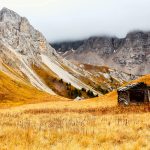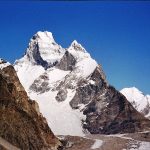Gasherbrum 1, also known as the “Hidden Peak,” is the 11th highest mountain in the world, standing at a towering height of 8,080 meters (26,509 feet). Nestled in the remote Karakoram Range on the Pakistan-China border, this majestic mountain is part of the Gasherbrum massif, a series of peaks renowned for their rugged beauty and challenging climbs.
This blog delves into the allure of Gasherbrum I, exploring its history, unique features, and the reasons it captivates adventurers and climbers from across the Gasherbrum 1 globe.
Why Is It Called the Hidden Peak?
The name “Gasherbrum” comes from the Balti words “rgasha” (beautiful) and “brum” (mountain), translating to “Beautiful Mountain.” Gasherbrum I, however, earned the moniker “Hidden Peak” due to its secluded position, shielded by other towering summits in the Karakoram Range. Its remote and less accessible location adds to its mystique, drawing explorers eager to conquer its formidable slopes.
Location and Surroundings
- Region: Gasherbrum I is located in the Gilgit-Baltistan region of Pakistan.
- Mountain Range: It is part of the Karakoram Range, home to some of the world’s tallest and most challenging peaks.
- Massif: Gasherbrum 1 shares the massif with Gasherbrum II, Gasherbrum III, and Gasherbrum IV.
- Proximity to K2: The peak lies near K2, the second-highest mountain in the world, and is surrounded by other iconic peaks, making it a centerpiece of mountaineering adventures.
The First Ascent of Gasherbrum I
Gasherbrum I was first summited on July 5, 1958, by an American expedition led by Nicholas Clinch, with climbers Pete Schoening and Andy Kauffman reaching the summit. Their remarkable feat remains a landmark in mountaineering history, as it showcased human endurance and determination in the face of one of nature’s most formidable challenges.
The climbers faced harsh weather, unpredictable avalanches, and extreme cold, making their ascent a testament to their skill and courage.
Unique Features of Gasherbrum I
- Pyramid-like Summit: The peak’s sharply defined, pyramid-like summit distinguishes it from other mountains in the range.
- Challenging Climbing Routes: Gasherbrum I offers steep faces, narrow ridges, and technical climbing routes that test even the most experienced mountaineers.
- Spectacular Glaciers: The mountain is surrounded by breathtaking glaciers, including the Baltoro Glacier and Abruzzi Glacier, which are among the longest in the world.
- Extreme Conditions: Known for its unpredictable weather and harsh winds, Gasherbrum I demands a high level of preparedness from climbers.
Why Climbers Are Drawn to Gasherbrum I
Gasherbrum 1 holds a special place in the hearts of mountaineers for several reasons:
- Prestige of an 8,000-Meter Peak: As one of the 14 peaks exceeding 8,000 meters, summiting Gasherbrum I is a significant achievement in the climbing community.
- Relatively Uncrowded: Unlike Everest or K2, Gasherbrum I sees fewer climbers, offering a more secluded and intimate climbing experience.
- Stunning Views: The ascent provides panoramic views of the Karakoram Range, including nearby peaks like K2, Broad Peak, and Gasherbrum II.
- Technical Challenge: Its demanding routes appeal to climbers seeking a blend of technical difficulty and high-altitude adventure.
Trekking to Gasherbrum I Base Camp
While climbing Gasherbrum I is reserved for elite mountaineers, trekking to its base camp is an achievable goal for adventurous trekkers. The journey begins in Skardu, a gateway town in Gilgit-Baltistan, and follows a challenging but rewarding route:
- Askole to Baltoro Glacier: Trekkers traverse rugged terrain, crossing the awe-inspiring Baltoro Glacier.
- Concordia: Known as the “Throne Room of the Mountain Gods,” Concordia offers unparalleled views of Gasherbrum I, K2, and Broad Peak.
- Gasherbrum Base Camp: The final destination provides a close-up view of the majestic Gasherbrum massif.
Challenges of Climbing Gasherbrum I
Climbing Gasherbrum I is not for the faint-hearted. The mountain poses several challenges:
- Altitude: At over 8,000 meters, climbers face the risk of altitude sickness.
- Unpredictable Weather: Sudden snowstorms and extreme cold are common.
- Technical Difficulty: The steep ridges and icy slopes demand advanced climbing skills.
- Physical Endurance: Climbers need exceptional fitness to endure the prolonged and grueling ascent.
Despite these challenges, the mountain’s allure continues to draw adventurers seeking to test their limits.
The Role of Local Communities
The local Balti people, known for their resilience and mountaineering expertise, play a vital role in expeditions to Gasherbrum I. Many serve as porters, guides, and support staff, sharing their deep knowledge of the region. Supporting local communities by hiring their services and respecting their culture is crucial for sustainable tourism.
Environmental Conservation
As tourism in the Karakoram grows, preserving the fragile environment around Gasherbrum I is more important than ever. Visitors can contribute by:
- Minimizing Waste: Carry reusable containers and dispose of trash responsibly.
- Sticking to Trails: Avoid damaging pristine landscapes by following designated routes.
- Respecting Wildlife: Protect the area’s unique flora and fauna by maintaining a safe distance.
Sustainable practices ensure that future generations can enjoy the beauty of Gasherbrum I.
Table of Contents
Tips for Visiting Gasherbrum I
Whether you’re trekking to the base camp or planning an ascent, here are some essential tips:
- Acclimatize Properly: Spend time at lower altitudes to adapt to the thin air.
- Hire Experienced Guides: Local guides can enhance your safety and experience.
- Prepare for Extreme Weather: Carry appropriate clothing and equipment for sudden temperature changes.
- Stay Hydrated: Drink plenty of water to combat the effects of high altitude.
Why Gasherbrum 1 Should Be on Your Bucket List
Gasherbrum I is more than just a mountain; it’s a symbol of nature’s grandeur and the human spirit’s resilience. Its remote beauty, towering presence, and challenging climbs make it a dream destination for adventurers. Whether you’re an experienced climber or a trekking enthusiast, Gasherbrum I offers a unique opportunity to connect with the raw beauty of the Karakoram Range.
Exploring Gasherbrum I is a journey into the heart of one of the world’s most dramatic landscapes. It’s a place where adventure, serenity, and natural splendor converge, leaving visitors with memories that last a lifetime.


